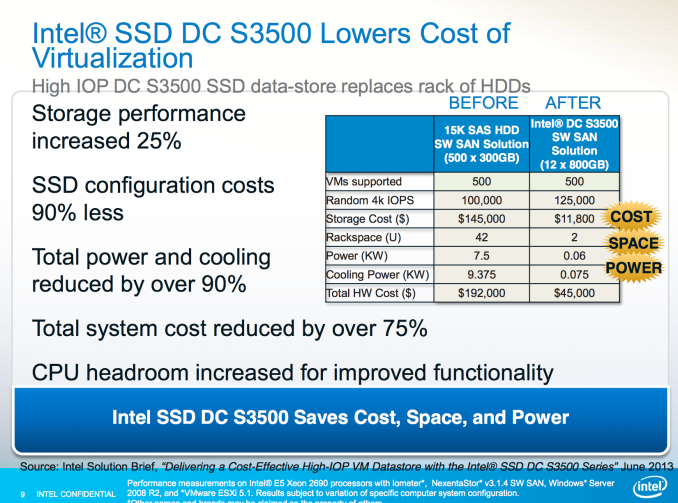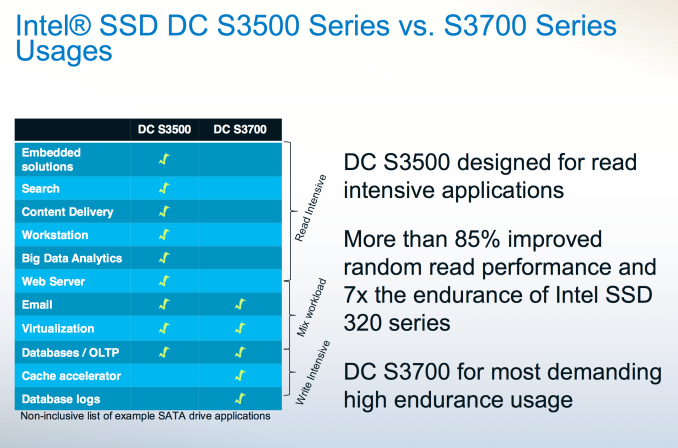Intel SSD DC S3500 Review (480GB): Part 1
by Anand Lal Shimpi on June 11, 2013 6:10 PM EST- Posted in
- Storage
- IT Computing
- SSDs
- Intel
- Datacenter
- Enterprise
Final Words
In our first high level look, Intel's SSD DC S3500 looks to be everything we loved about the S3700 but at a more affordable price point for enterprise customers who don't need insane amounts of write endurance. With SSDs in the enterprise there's this tendency to over estimate endurance needs. I was guilty of it in the design of our SSD requirements for serving AnandTech. Part of the problem is there aren't tons of good software applications to quietly monitor/report/analyze enterprise workload behavior. I suspect that for the vast majority of use cases however, the S3500 is likely more than enough. Even though the AnandTech database servers (content, stats tracking and forums) are fairly write intensive, the S3500 is actually the right target for us - the S3700 would deliver far more endurance than we'd ever use.
Other than write endurance, the only other thing you give up is random write performance. Intel's specs list the S3500 at roughly 1/3 of the sustained 4KB random write performance of the S3700, which I saw in our numbers as well. Given the lower price point however, most customers are likely comparing performance to an array of hard drives. On an individual level, a good high-end HDD will provide somewhere around 1 - 2MB/s in 4KB random write performance. The S3500 by comparison is good for about 40MB/s. Intel's own data shows that 12 S3500s will deliver roughly the same random IO as 500 15K RPM hard drives. Based on the data I've seen, that comparison is pretty accurate.
All of the other S3700 benefits remain. Performance consistency is excellent, which makes the S3500 ideal for use in many-drive RAID arrays. Intel's enterprise drives have typically done very well in terms of reliability as well (and I haven't heard any complaints about the S3700), making the S3500 a safe bet. My only real complaint about this drive is the idle power rating is too high for notebook use, because otherwise I'd even suggest looking at the S3500 for consumer use as well.
All in all I've been pleased with Intel's work in the enterprise SSD space. Most interesting to me is just how aggressive Intel has been in terms of enterprise SSD pricing. The S3500 shows up at well under $1.50/GB, and consumer drives aren't that far off in terms of pricing. Intel typically doesn't push this aggressively for lower prices with its enterprise products, so when it happens I'm very happy.












54 Comments
View All Comments
Minion4Hire - Tuesday, June 11, 2013 - link
I believe that's just the writes they guarantee the drive for. There's write amplification and maintenance to consider there as well.ShieTar - Wednesday, June 12, 2013 - link
Well, they have to keep the S3700 useful enough to sell both. So they tailor the specs a bit in order to push customers into buying the "right" drive.ShieTar - Wednesday, June 12, 2013 - link
Then again, if this is guaranteed for the whole range, its an impressive number for the small 80GB drive.pesos - Tuesday, June 11, 2013 - link
How about performance over time in virtualization scenarios? Wondering how well these SSDs hold up when they have nothing on them but virtual hard disks...dealcorn - Tuesday, June 11, 2013 - link
In Part 2, could you kindly note whether the Drive supports DEVSLP. Depending on usage pattern, not considering the drive for mobile use based on idle power requirements may be inappropriate.sunbear - Tuesday, June 11, 2013 - link
Looking at the consistency comparison against the seagate 600 pro, it looks like the intel s3500 is more consistent but unfortunately it's consistently slower in every metric. I'd rather have a seagate 600 pro with inconsistent performance if the minimum performance if that drive is better than the maximum performance of the s3500.beginner99 - Wednesday, June 12, 2013 - link
I had the same thought. agree.hrrmph - Friday, June 14, 2013 - link
As an individual drive maybe.For RAID, the slowest drive in the array will probably control the overall I/O rate. In that case, I don't see an advantage for Seagate over Intel.
As I see it, the S3500 is a pro-sumer high-end workstation drive for RAID arrays, and a mid-range enterprise class drive. The S3700 is clearly a full-on high-end enterprise class drive.
We'll have to wait for Part 2 of the article and hope that Anand gives us some comparisons to the consumer 520 series to see if there is any reason to buy an S3500 instead of a 520.
Intel is being suspiciously quiet about the upcoming 530 series SSDs. I expect that we'll be looking at another low power consumption, high performance, relatively affordable SSD using a non-Intel controller. But, it would be nice if we could have all of that with an Intel controller instead.
-
rs2 - Wednesday, June 12, 2013 - link
What's the deal with the first slide from Intel shown in the conclusion? Specifically, how is a 12x800GB (9.6 TB) deployment comparable to a 500x300GB (150 TB) deployment?The only way you can get 500 VM's on such a deployment is if you allocate only ~20 GB per VM. That's anemic. And if that's the allocation size then the 500x300GB can support over 7500 VM's.
So...yeah, not seeing how a valid comparison is being made. Intel should be quoting figures based upon ~192 SSD's, because that's how many it takes to reach the same storage capacity as the solution it's being compared to.
flyingpants1 - Wednesday, June 12, 2013 - link
I noticed the same thing.